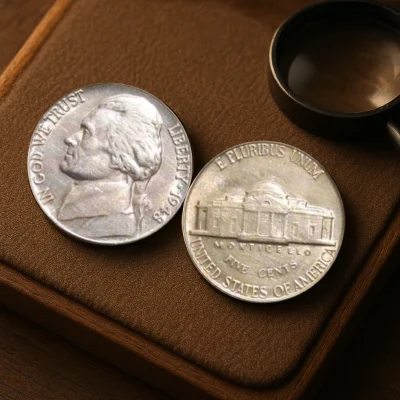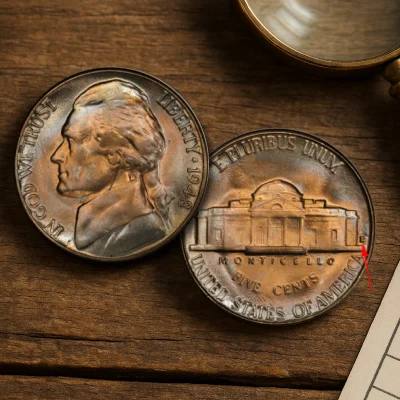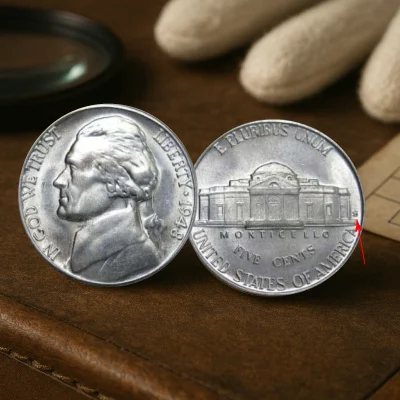
The 1948 Jefferson nickel looks just like any other five-cent coin, but it is highly valuable to collectors. Minted in Philadelphia (no mint mark), Denver ("D"), or San Francisco ("S"), this post-World War II coin can be worth more than its face value depending on the condition of the coin, the mint, and possible errors.
In this guide, we’ll break down the 1948 nickel’s value, including key grading details like “Full Steps,” error varieties to watch for, and historical context. You’ll learn what makes certain 1948 nickels worth more and how to evaluate them confidently for collecting, trading, or long-term numismatic interest.
The 1948 Jefferson nickel looks just like any other five-cent coin, but it is highly valuable to collectors. Minted in Philadelphia (no mint mark), Denver ("D"), or San Francisco ("S"), this post-World War II coin can be worth more than its face value depending on the condition of the coin, the mint, and possible errors.
In this guide, we’ll break down the 1948 nickel’s value, including key grading details like “Full Steps,” error varieties to watch for, and historical context. You’ll learn what makes certain 1948 nickels worth more and how to evaluate them confidently for collecting, trading, or long-term numismatic interest.
The Jefferson nickel of 1948 was issued shortly after World War II, when the United States came back to normal coin metal. The wartime nickels, composed of silver, no longer had the same composition of 75% copper and 25% nickel in 1948 coins. Felix Schlag designed the coin, which features the face of Jefferson and Monticello and has had an identical appearance since its original release in 1938.
There was economic growth and stability in the United States in 1948, and the year's Jefferson nickel exemplifies this post-war normalcy. No evidence suggests that nickels were minted—only business strikes from Philadelphia, Denver, and San Francisco. Collectors nowadays appreciate 1948 nickels for their variation in mint marks, scarce high grade due to condition, and historical popularity with the post-war period.
In 1948, the Jefferson nickels were produced in three of the facilities of the U.S. Mint: Philadelphia, Denver, and San Francisco. The production of each mint determines the availability and value of the coin. Identifying the mint mark matters to the collector since it adds background and, in some cases, value from scarcity or historical context.

89,348,000 nickels were minted in 1948 at the Philadelphia Mint, the year high mintage. The coins bear no mint mark on the back (to the right of Monticello). With so many struck, Philadelphia 1948 nickels are absurdly plentiful in all grades and are generally worth face value in worn condition.
The 1948 no-mintmark (Philadelphia) Jefferson nickel is readily found in circulated grades and is worth only 10¢ to 50¢. Uncirculated specimens cost $1 to $20, but scarce MS67 specimens with Full Steps are hard to find and well over $1,000. Most ones found in pocket change are low grades and do not have a collector premium unless in mint state.
| Grade/Condition | Estimated Value Range | Notes |
|---|---|---|
| Circulated (Fine–VF) | $0.10–$0.70 | Very common; minimal premium |
| Uncirculated (MS60–MS63) | $1–$3 | Bright luster, few marks |
| Choice MS (MS65) | $10–$20 | Gem condition: collector quality |
| Premium Grade (MS66) | $40–$100+ | Scarce; some auction competition |
| Top Grade (MS67) | $1,000–$1,650+ | Rare, especially with Full Steps designation |

44,734,000 nickels were struck by the Denver Mint, the second-most issued of 1948. The coin has a small "D" to the right of Monticello. Not as rare as Philadelphia coins, 1948-D nickels are still plentiful and inexpensive, particularly in circulated grades.
The 1948-D Jefferson nickel is fairly normal, and circulated coins tend to sell in the $0.40-$1.00 range. Uncirculated coins sell for $2-$20, but high-grade MS67s go for $275. Highly well-struck Full Steps proofs can command hundreds of dollars, though most are only worth small amounts. It is still a low-budget collector coin in low grades.
| Grade/Condition | Estimated Value Range | Description |
|---|---|---|
| Circulated (Fine–VF) | $0.40–$1.00 | Common and affordable in worn condition, little collector premium. |
| MS60–MS64 | $2–$6 | Basic uncirculated coins, lightly marked with average luster. |
| MS65 | $10–$15 | More eye appeal, fewer marks; moderately scarce |
| MS66 | $20–$40 | Scarcer, strong luster, and cleaner surfaces. |
| MS67 | $200–$300 | High-grade rarity; fewer survivors in this pristine condition. |
| MS67 Full Steps (FS) | Up to $6,325 | Exceptional strike; rare and valuable for advanced collectors. |

San Francisco produced 11,300,000 nickels, the year's smallest production. The coins feature an "S" mint mark on the back. Although it is the year's smallest production, 11 million is considerable, so 1948-S nickels are only marginally rarer. They are just a bit more expensive, but not rare in most grades.
The 1948-S nickel, while having the lowest mintage of the year, is still abundant in circulated condition and generally retailed for $0.25–$1.00. MS coins in $2–$22, but MS67s are $200–$250. Extremely scarce Full Steps coins are thousands of dollars—$12,000 was paid for one, a record value of a 1948 nickel.
| Grade/Condition | Estimated Value Range | Description |
|---|---|---|
| Circulated (Fine–VF) | $0.40–$1.00 | Despite low mintage, still common and affordable in worn condition. |
| MS60–MS64 | $2–$6 | Entry-level Mint State; widely available and budget-friendly. |
| MS65 | $10–$15 | Good quality with minor marks; modest collector premium. |
| MS66 | $20–$40 | Sharper strike and better surfaces; slightly scarcer. |
| MS67 | $200–$300 | Tougher grade to find; fewer high-end survivors from San Francisco. |
| MS67 Full Steps (FS) | Up to $6,325 | Top-pop, museum-grade coins; extremely rare and highly valuable. |
The most crucial is to identify the mint mark—no letter for Philadelphia, "D" for Denver, or "S" for San Francisco. They're all familiar, but there are slight value differences. The real premium is in condition and special types, not necessarily which mint made the coin.
While the standard 1948 nickels are common, error coins and varieties from that year can be quite exciting for collectors. Error coins are pieces that have some sort of minting mistake, making them unique. Here are some known 1948 nickel errors/varieties and their impact on value:
A doubled die 1948 nickel exhibits doubling in Jefferson's eye or "LIBERTY." Due to an error of misaligned hubbing of the die, such varieties become sought after by collectors. Solid specimens command prices of $25–$50 or higher, particularly in high grade. Examine closely for doubling under magnification on inscriptions and design.
1948-D and 1948-S nickels with repunched mint marks that have doubled "D" or "S" are the result of human repunching errors. RPMs are not common but are still worth money. Most will bring $5–$15 based on visibility and grade. More choice and extreme repunching pieces can command higher premiums from variety collectors.
Off-center striking creates off-center 1948 nickels. A 5–10% off-center can be worth $3–$10, and 50% off-center with date visible may sell for $75+. These beautiful errors are one-of-a-kind and beautiful to behold. San Francisco nickels do offer some off-center problems. Always examine date readability and strike a balance.
Die cracks are raised lines since a worn die has cracked. Small cracks add a few dollars to value, whereas large die breaks (cuds) are worth $50–$100. They occur when metal fills up die breaks and are worth the effect on appearance. Value depends on size and position.
Lamination mistakes are produced by defects in the metal alloy, peeling or broken surfaces. Such a defective 1948 nickel can be plagued by flaking or missing sections of metal. Mistakes are worth between $5 and $50, depending on the severity. Although not a literal layering of metal, the term is employed to characterize incorrect metal make-up when striking.
The 1948 Jefferson nickel is not rare in circulation. Each of the three mints—Philadelphia, Denver, and San Francisco—struck millions of coins, and all but the most mutilated remain intact. Common-date specimens in worn condition are readily available in rolls or dealer stock and typically have little intrinsic value.
All that being said, there exist some conditions that can make a 1948 nickel rare:
A high-mintage coin that is readily available, the 1948 Jefferson nickel is not one with great return potential. Its availability and high mintage restrict long-term appreciation, aside from ultra-high graded MS66+ with Full Steps. As a collector, though, it is worthwhile—ideal for novices, budget-conscious accumulators, or those looking to complete a complete Jefferson nickel set.
Recommendations by collectors are
Remember, collect 1948 nickels for hobby and history appreciation—not investment profit.
The 1948 Jefferson nickel is one of the timeless coins of post-war American numismatics that never seems to go out of fashion. Although most circulated copies are only worth pennies, the coin is historic and an extension of a long-running issue of Thomas Jefferson and Monticello. The large mintages in all three mints—Philadelphia, Denver, and San Francisco—translate into available copies of most 1948 nickels, particularly in lower grades. Yet, for example, uncirculated coins, especially Full Step pieces, can command high prices depending on condition.
This coin signals the U.S. Mint's return to vintage copper-nickel alloy post-WWII and the timeless charm of Felix Schlag's design. It is an excellent beginning for novice collectors starting a Jefferson nickel set, while high-grade specimens such as MS67 or MS67+ Full Steps continue to be sought after by seasoned collectors. Various highest-grade specimens have brought thousands at auction, demonstrating that it is quality and not age or mintage figures that the market demands premiums for.
Quite simply, the 1948 nickel is inexpensive and affordable to collect. To fill a slot machine or to invest in a superior example, its worth is based on preservation and scarcity. For reasonable prices and low premiums, buy with confidence from BOLD Precious Metals—your source of trust and value.
How much is a 1948 nickel without a mint mark worth?
In circulated condition, it's worth between 10¢ and 50¢. Uncirculated examples can range from $1 to $30. Only top-graded MS67+ nickels with Full Steps may sell for $1,000 or more, but most remain under one dollar.
How much is a 1948-D nickel worth?
In circulated grades, 1948-D nickels are worth about 50¢ to $1. Uncirculated coins range from $2 to $15, while MS67 Full Steps examples can sell for $6,000+. These coins are still common and widely available.
Is there silver in a 1948 nickel?
No, 1948 nickels contain no silver. They are composed of 75% copper and 25% nickel. Only wartime nickels (1942–1945) contained silver; post-1945 coins returned to the regular composition.
Where is the mint mark on a 1948 nickel?
The mint mark is located on the reverse side of the coin, to the right of Monticello. A small "D" indicates Denver, "S" is for San Francisco, and no mint mark means it was made in Philadelphia. Use a magnifying glass or jeweler’s loupe if the mark is hard to see.
Are 1948 nickels scarce or difficult to obtain?
No, not in circulated condition. Millions were produced, making them common. Higher grades such as MS66+ or those with Full Steps are less common. Rare errors like doubled dies or off-center strikes are collectible and fetch higher prices.
What is the highest ever paid for a 1948 nickel?
The highest auction price for a 1948 nickel was $12,000 for a 1948-S MS67+ Full Steps. Other top sales include $6,300 for a 1948-D MS67 FS and $2,240 for a 1948-S MS68. These coins are ultra-rare in such grades.
How is the price of a 1948 nickel relative to that of a 1948 penny?
Both are common in circulated condition and typically worth just a few cents. However, the highest-quality 1948 pennies (MS67 Red) can bring in $2,000 — similar to rare nickels. Pennies are often more sought after due to their wheat design.
Do I clean my 1948 nickel to make it more appealing?
No — cleaning reduces the value of a coin. It removes original surfaces and can leave marks. Collectors prefer natural toning. Grading companies may label even lightly cleaned coins as "improperly cleaned," drastically lowering their value.






















